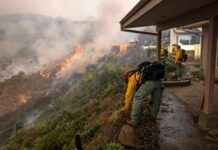Global Efforts to Address Drought Fail as Earth Continues to Dry
Countries worldwide gathered in Riyadh for the COP16 conference of the UN Convention to Combat Desertification (UNCCD), aiming to address the critical issue of drought. However, despite intense negotiations, a legally binding drought protocol could not be established, leaving a significant gap in global efforts to combat the drying of the Earth’s land.
Behind Closed Doors: The Stalemate in Riyadh
The talks in Riyadh took a dramatic turn as Africa pushed for a legally binding drought protocol, only to face opposition from the United States and other nations. The discussions stretched into overtime, with Saudi Arabia, the host nation, eventually closing the summit in the early hours of Saturday morning. The postponement of further debate to COP17 in 2026 underscored the challenges faced in reaching a consensus on addressing drought worldwide.
The Urgency of the Situation: Earth’s Land Continues to Dry
Scientists have issued dire warnings, highlighting that three-quarters of the Earth’s land has become permanently drier over the past 30 years due to human activities and climate change. This trend poses threats such as food shortages, increasing wildfires, large-scale forced migration, and other catastrophic consequences. The need for immediate action to combat drought and prevent further land degradation is more pressing than ever.
The Drought ‘Sticking Point’: Differing Perspectives on Solutions
The debate at COP16 revolved around various policy options to address drought, ranging from a legally binding protocol to a non-binding global framework. While some countries, including the African Group, advocated for a binding agreement, others, such as the United States, argued against it, citing local causes of drought and the need for tailored responses instead of a global policy.
The Path Forward: Finance and Inclusivity
Amidst the stalemate on a drought protocol, some progress was made in financial support for drought-affected nations. The Riyadh Global Drought Resilience Partnership was launched, with pledges exceeding $12 billion from various sources. However, this falls short of the estimated $2.6 trillion needed by 2030 to address drought and land degradation effectively.
Additionally, the conference approved decisions to establish official groupings for Indigenous peoples and local communities, expanding the UNCCD’s focus to include pastoralism and various types of rangelands. These efforts aim to ensure that diverse voices are heard in addressing land degradation and drought, acknowledging the importance of inclusivity in shaping effective solutions.
As the world grapples with the impacts of climate change and land degradation, the failure to reach a consensus on a global drought mechanism at COP16 underscores the complexities and challenges of addressing environmental issues on a global scale. The road ahead requires continued collaboration, innovation, and a shared commitment to safeguarding the planet for future generations.
Let’s take a moment to reflect on the interconnectedness of our actions and their impact on the environment. What steps can we each take to contribute to a more sustainable future and mitigate the effects of drought and land degradation in our communities? Together, we can make a difference and protect the Earth’s precious resources for generations to come.














